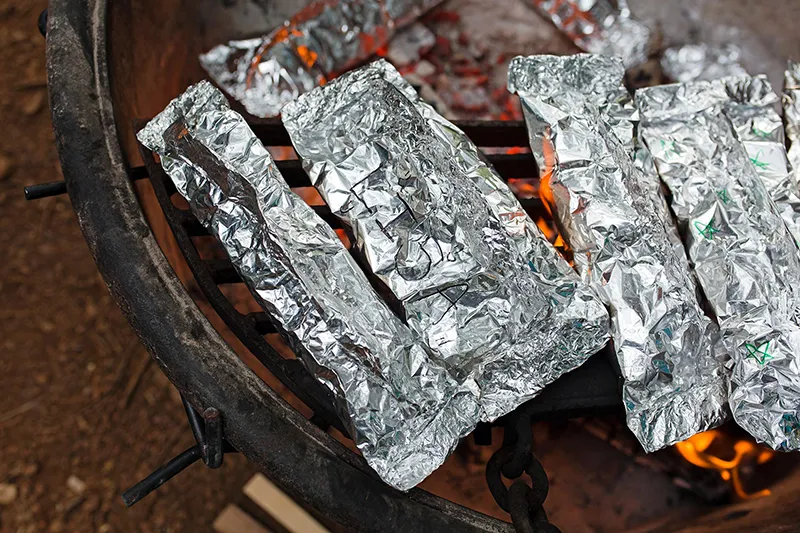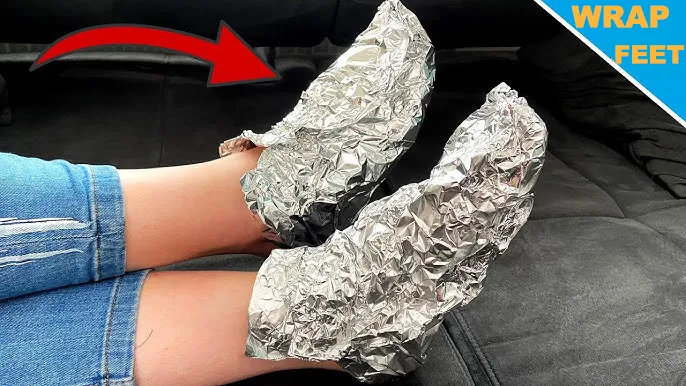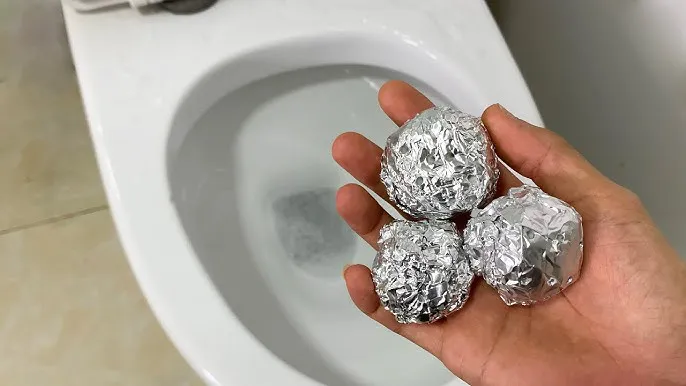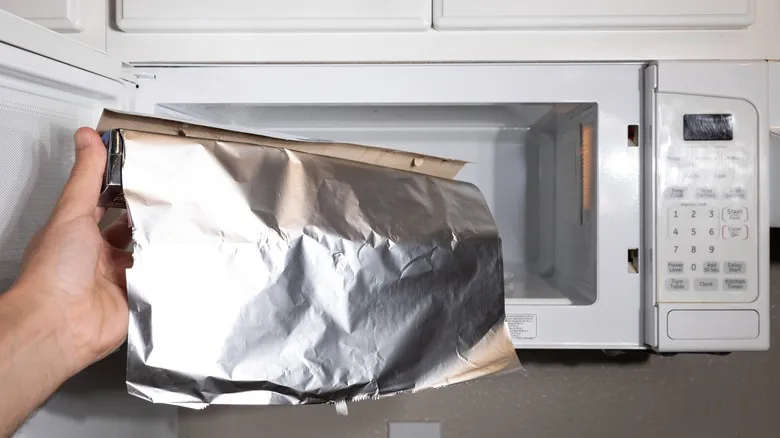Why Should You Avoid Aluminum Foil?
It is well known that aluminum may be linked to Alzheimer’s disease. Long-term exposure to aluminum can lead to aluminum poisoning, which can cause bone pain, anemia, and nerve damage. Because aluminum accumulates in the body, especially in the bones, kidneys, brain, lungs, liver, and thyroid, it competes with calcium for absorption and affects bone health.
Aluminum can leach into food, especially when used with acidic foods such as tomatoes, citrus fruits, or spices. This leaching is more obvious at higher temperatures, such as when cooking in a microwave or oven.
The above are the reasons why some people do not use aluminum.
Is Aluminum Foil Toxic When Heated?
While aluminum foil has a layer of inert aluminum oxide and is generally harmless, high temperatures or prolonged heating can cause changes in the material that may release harmful substances.

Heating aluminum foil can cause metals to leach into food, which can cause aluminum poisoning. This is because aluminum foil contains aluminum and lead, which react chemically when heated, causing these metals to leach into food.
Aluminum leaching into food poses health risks, including aluminum poisoning, which can cause bone pain, anemia, and nerve damage.
But food-grade packaging aluminum foil has standards for toxic elements such as lead, cadmium, and arsenic, and while these standards do not completely eliminate the risk, they are generally safe to use under normal conditions.
What Happens If You Wrap Your Feet In Aluminum Foil?
Wrapping your feet in foil can have a variety of effects that can be both helpful and harmful:

Benefits:
- Temporary relief of foot ailments: Wrapping your feet in foil can temporarily relieve soreness, swelling, and discomfort. The tight wrap helps compress the tissues of the foot, reducing inflammation.
- Improves circulation: Foil is thought to reflect body heat back to the feet, which can help improve circulation and provide a soothing effect.
- Relieves pain: Using foil on other painful areas of the body can help reduce pain intensity and speed healing.
- Reduces inflammation: Wrapping your feet in foil can act as an anti-inflammatory, helping to relieve joint pain and reduce inflammation.
Potential Risks:
- Skin irritation: Using foil on your skin for a long time may cause irritation, especially if you have sensitive skin or any existing abrasions or wounds. The material of foil may rub against the skin, causing friction or pressure sores, especially when worn for long periods of time.
- Restricts air circulation: Wrapping your feet in foil creates a barrier that restricts air circulation. Feet naturally sweat easily, and wrapping tightly in foil can trap moisture and heat, leading to discomfort, fungal infections, or bacterial growth.
- Lack of scientific consensus: While some claim that wrapping your feet with aluminum foil can help relieve pain by reducing inflammation and improving blood flow, there is no strong scientific evidence to support these claims.
- Overheating and burns: Aluminum foil reflects heat, and if you use it as a heat source (e.g., after a heat treatment or as part of a heat therapy procedure), it can cause overheating or burns if the foil is too hot and used for too long.
Why Put Aluminum Foil In A Toilet Tank?

Here are some reasons why people put aluminum foil in their toilets:
Placing a layer of aluminum foil in your toilet tank helps reduce water waste.
It is thought that the foil deionizes the water in the tank, which reduces turbidity. This helps ensure that fecal matter enters the main sewer line without causing a clog.
Aluminum foil helps keep your toilet tank clean by preventing the buildup of minerals and other contaminants. This results in a cleaner flush and a more sanitary toilet environment.
Some people report that using aluminum foil in their toilet tank helps prevent yellowing and reduces bad odors, even if the toilet has not been cleaned in months.
Is Aluminium Foil Banned?
Aluminum foil is not generally banned. However, in certain contexts and regions, aluminum foil has been restricted or proposed to be restricted:
Kenya: Kenya updated its household aluminum foil standard, indicating a regulatory change but not a ban.
India: India launched an anti-dumping investigation into aluminum foil imports, indicating a regulatory review but not a ban.
EU: The EU has conducted several anti-dumping investigations into aluminum foil from China, which affects trade but does not constitute a ban.
While there are regulatory actions and investigations involving aluminum foil, there is no evidence of a general ban on its use.
What Do British People Call Aluminum Foil
British people commonly refer to aluminum foil as “tin foil,” “cooking foil,” “kitchen foil,” or “baking foil”.
In the UK, aluminium foil is often referred to as “tinfoil.” The term dates back to a time when tin was more commonly used for such products, although most modern “tinfoil” is actually made from aluminium.
Should Aluminum Foil Be Shiny Side Up Or Down?
The debate over whether foil should be shiny or dark is common, but it mostly comes down to personal preference or specific use.

Normally, the shiny side of foil reflects heat better than the dark side. If you’re using foil for cooking, the shiny side facing up may reflect heat back toward the food. Conversely, the dark side absorbs slightly more heat than the shiny side. Therefore, the dark side should be facing up.
When baking or roasting, it usually doesn’t matter which side is up, but if you want your food to cook faster or receive more heat, you may prefer the shiny side facing the food. For slow cooking or holding heat, the dark side facing the food may be better. The difference in heat reflection between the two sides becomes more important when grilling foil. The shiny side facing outward can help reflect heat back toward the food, potentially giving it a crispier texture.
Why Not Cover Food With Aluminum Foil?
One of the main issues with using aluminum foil, especially when used to wrap food, is the potential for aluminum to leach into the food. When aluminum foil comes in direct contact with acidic or salty foods (like tomatoes, citrus, or meat), high temperatures or prolonged contact can cause small amounts of aluminum to migrate into the food, which can build up in the body over time. While research on health risks is inconclusive, some studies suggest that excessive exposure to aluminum may contribute to neurological disorders like Alzheimer’s disease.
But this is still just speculation, not actual proof.
What’s The Difference Between Aluminum Foil And Tin Foil?
The terms “aluminum foil” and “tin foil” are often used interchangeably, but are they really the same?
Aluminum foil and tin foil are actually not the same.
Tin foil was widely used for a variety of purposes in the early 20th century, but aluminum foil did not replace tin foil until the mid-20th century.
Tin foil is made primarily of tin, which makes it malleable and corrosion-resistant, but also more easily torn and damaged.
Aluminum foil is made of aluminum, a lightweight and abundant metal that is more durable and flexible than tin foil.
Aluminum foil is thinner, stronger, and more flexible than tin foil, making it a popular choice for cooking and baking. While tin foil was once common, its use has decreased over time due to its relative fragility and tendency to react with acidic foods.
Is There A Wrong Way To Use Aluminum Foil?

- Wrapping Acidic Foods: While aluminum foil is generally safe for most foods, wrapping acidic foods (like tomatoes, citrus fruits, or vinegar-based dishes) may chemically react with the foil. This can cause the food to have an unpleasant taste or even leach aluminum into the food, posing a potential health risk.
- Cooking at Extremely High Temperatures: Using aluminum foil at extremely high temperatures (especially over a direct flame, such as on a grill) can cause the foil to burn or even disintegrate.
- Using aluminum foil in the microwave: One of the most common “wrong ways” to use aluminum foil is to put it in the microwave. Metal can spark and pose a fire hazard. Even small pieces of foil can interfere with the microwave’s magnetic field, causing sparks or arcs.
Is It Safe To Use Old Aluminum Foil?
Aluminum foil is a staple in kitchens around the world due to its durability, flexibility, and ease of use. However, when it comes to reusing old aluminum foil, many people wonder: is it still safe?
If aluminum foil is wrinkled, torn, or has been used to wrap foods with strong flavors or acidic ingredients, it is not suitable for reuse.
If aluminum foil has been used to wrap or cover greasy or wet foods, it should be cleaned thoroughly before reuse. Aluminum foil with food residue may breed bacteria or mold, making it unsuitable for continued use.
Aluminum foil has been folded and wrinkled many times, and it may not provide the same degree of protection or insulation.
If you want to reuse aluminum foil, make sure that the foil is completely free of food residue. Gently wipe or rinse under warm water, taking care to remove any grease, crumbs, or remaining food particles. Before using, inspect the foil for any visible damage. Small holes or tears can lead to contamination or spills during cooking or storage.
In short, as long as the old aluminum foil is still in good condition (no tears and food residue), it is safe to reuse.



